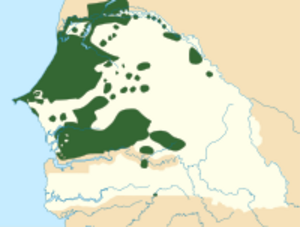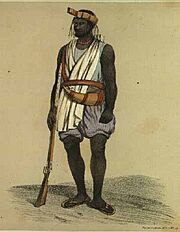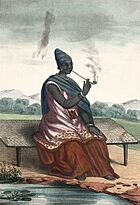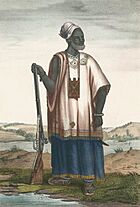Wolof people facts for kids
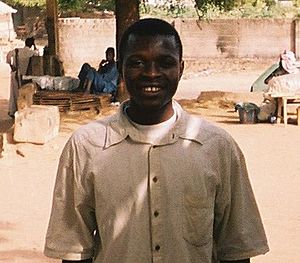
A Wolof man in the Gambia
|
|
| Total population | |
|---|---|
| ~7,676,940 | |
| Regions with significant populations | |
| 7,192,000 | |
| 300,000 | |
| 230,000 | |
| Languages | |
| Wolof • French • English • | |
| Religion | |
| Predominantly Sunni Islam | |
| Related ethnic groups | |
| Serer people, Diola people, Lebou people | |
The Wolof people are a large group of people living in West Africa. Most Wolof people live in northwestern Senegal, the Gambia, and southwestern coastal Mauritania. In Senegal, the Wolof are the biggest group, making up about 39.7% of the population. In other places, they are a smaller group.
The Wolof people call themselves Wolof. They speak the Wolof language, which is part of the Niger–Congo family of languages. Their early history is not fully known. The first time the Wolof were written about was in the 1400s by a traveler named Alvise Cadamosto. He wrote about Wolof leaders who were advised by Muslim helpers. The Wolof were part of a powerful kingdom called the Wolof Empire in the Senegambia region.
Over time, many Wolof people became Muslims. Today, most Wolof people follow the Sufi branch of Islam. The Wolof people have a long history and have greatly influenced the culture and economy of Senegal since it became independent in 1960. They are also known by names like Wollof, Jolof, and Olof.
Contents
What's in a Name?
The word Wolof can mean a few things. It refers to the people, their language, and their traditions. In older French books, you might see it spelled Ouolof. Other old spellings include Wolluf, Volof, and Olof.
The spelling Jolof is often used when talking about the Jolof Empire and Jolof Kingdom. These were important states in central Senegal from the 1300s to the 1800s. You might also know the name from a popular West African dish called Jollof rice.
History of the Wolof People
The exact beginnings of the Wolof people are a bit of a mystery. Scientists have found old pottery and other items in Senegal and the Gambia. These items are from hundreds of years ago, but they don't clearly show a link to only the Wolof people. The name "Wolof" first appeared in writings by Portuguese travelers in the 1400s.
One idea is that the Wolof people moved into northern and eastern Senegal after Arab groups arrived in West Africa. Over time, their villages grew into independent states like Baol and Kayor. These states later joined together to form the Jolof Empire. This move might have happened around the late 1000s.
Another story is a legend from the Walo region. It tells of a mysterious person named Ndyadyane Ndyaye who came from a lake to solve a village dispute. His family became the leaders of the Wolof people. From the 1400s onwards, the Wolof's history is full of powerful families, wars, and changes in power.
The Wolof Empire
The Jolof or Wolof Empire was a powerful state in West Africa. It ruled parts of Senegal and the Gambia from about 1350 to 1890. The Wolof way of governing, their social classes, and their culture were very important in north-central Senegal for about 800 years. The empire ended when French colonial forces took control in the late 1800s. This also marked the start of Senegal becoming a single country.
By the late 1400s, several Wolof states had joined together under the Jolof Empire. The main ruler was called the Burba Wolof. Other state leaders showed loyalty and paid taxes to him. Before trading with Portuguese merchants, the Wolof people had already traded goods and people with other empires in Western Sudan and North Africa.
Slavery and Its End
Historically, slavery was a part of Wolof culture. Before Europeans arrived, people became slaves by being born into it, bought, or captured in wars. Starting in the 1500s, Portuguese traders began buying slaves from ports in Senegambia. These slaves often passed through Wolof lands on their way to the coast. As Europeans wanted more slaves in the 1600s and 1700s, the Wolof people increased their raids to capture people for trade.
The trade also brought European firearms to the Wolof, which were often exchanged for slaves. These weapons led to more intense conflicts. However, the slave trade slowly ended as European and American governments made it illegal. During the time of New Imperialism, most of Africa, including Wolof lands, came under European colonial rule. These new rulers worked to end slavery, and by the 1890s, the French had largely stopped it in West Africa. Even after slavery was officially ended, the social differences between free-born Wolof and former slaves remained for a long time.
Where Wolof People Live
The Wolof people are the largest ethnic group in Senegal. They mostly live in the northwestern part of the country, near the Senegal River and the Gambia River. In the Gambia, about 16% of the population is Wolof. Even though they are a smaller group there, their language and culture are very important, especially in Banjul, the capital city. In Mauritania, about 8% of the population is Wolof. In total, there are more than 6 million Wolof people across these three countries.
Religion and Beliefs
Most Wolof people are Sunni Muslims. However, their religious practices often include local traditions. The mix of old beliefs and Islam has led to the growth of Sufi traditions.
We don't know much about the Wolof's religious traditions before Islam. Their oral stories say they have been Muslim since the very first king of their Kingdom of Jolof. But historical records from Muslim scholars and European travelers suggest that Wolof kings and warriors did not become Muslim right away. They did, however, rely on Muslim religious leaders for advice.
Some scholars believe that old Wolof beliefs about good and bad spirits (called jinn), special charms, dances, and other rituals might have become part of their Sufi beliefs.
In the 1700s and later, the Wolof were affected by religious conflicts in West Africa. These conflicts caused disagreements about Islam among the Wolof. In the 1800s, as French colonial forces fought against the Wolof kingdoms, many Wolof people resisted the French and became Muslim. Today, most Wolof people are Sufi Muslims, belonging to groups like the Mouride and Tijaniyyah brotherhoods.
These Sufi Muslim brotherhoods became very important in Wolof communities in the 1800s and 1900s. Their leaders, called marabouts, have a lot of cultural and political influence among most Muslim groups, especially the leader of the Mouride brotherhood.
Wolof Culture
The traditional culture and practices of the Wolof people have lasted through the colonial period. They are a strong part of the Senegalese culture today.
Language of the Wolof
Wolof (/ˈwɒlɒf/) is the main language of the Wolof people. It is spoken in Senegal, the Gambia, and Mauritania. Like other nearby languages, it belongs to the Senegambian branch of the Niger–Congo language family. Unlike many languages in Africa, Wolof does not use tones to change the meaning of words.
Wolof started as the language of the Lebu people. It is the most widely spoken language in Senegal. While it's the native language for about 40% of the population, most other Senegalese people also speak it as a second language.
Wolof dialects can be different depending on the area, like in the countryside versus cities. For example, "Dakar-Wolof" is a city mix of Wolof, French, and Arabic.
Social Structure
For a long time, at least since the 1400s, the Wolof people have had a strict social system. This system was passed down through families.
There were different social groups:
- The geer were the freeborn people.
- The nyeenyo or neeno were people in specific castes, often linked to certain jobs.
- The jaam were slaves.
People usually married within their own social group. This was a very strong rule among the Wolof. Being in a certain caste was often a bigger barrier to marriage than a person's ethnic group or religion in Senegal.
The castes also had their own order. The lowest caste was often the griots, who were storytellers and musicians. Their jobs were sometimes seen as less important. For example, leatherworkers were considered lower because their work with animal skins was seen as unclean.
Historically, slaves were a separate group. They were either born into slavery, kidnapped, bought, or made slaves as punishment. Slaves could not marry without their owner's permission.
Even the freeborn geer had a hierarchy. At the top were the royal rulers. Below them were noble families who controlled land and collected taxes. Below them were common freeborn people called baadoolo, meaning "lacking power."
The exact start of this social system is not clear. Some think it grew as slavery increased around the 1400s. Others believe it started earlier, around the 900s, because slavery was already common then. Historically, the Wolof were a matrilineal society (where family lines are traced through the mother) before the 1300s. Later changes, like those during the Wolof Empire, shifted them to a patrilineal system (tracing family lines through the father). These social divisions and marriage rules have continued even after Senegal became independent.
Wolof Households and Villages
Most Wolof people (about 75%) live in the countryside, in small villages. In the past, they lived in larger settlements before wars and slave raids.
Wolof villages are made up of groups of compounds. A compound might have several round or square huts. These huts are often made from mud and millet stalks, with cone-shaped thatched roofs. Sometimes, a fence made of reeds surrounds a compound.
A single compound can have many huts. The head of the compound is usually a man, and in families with more than one wife, each wife and her children might live in a different hut. Traditionally, everyone in a compound shared a kitchen. If there were disagreements, each family cooked separately.
A village is led by a chief, called the borom dekk. This role is usually passed down through families. The chief used to collect taxes and connect the villagers with the kingdom's officials. Often, the chief is also a Muslim religious leader, called seriñ or marabout. Larger villages have an imam, who leads prayers, and a leader for hunters or warriors. These roles were also often passed down through families. Relationships in a village are based on respect for authority. Disputes are usually settled by mediators or by Muslim judges called qadi.
Marriages
Marriages among the Wolof are usually within the same social group. A common type of marriage is between a man and his mother's brother's daughter. It's common for men to have more than one wife. When a couple marries, the groom's family usually pays a brideprice to the bride's family. Divorce is also common and follows Islamic rules.
While slavery is illegal today, it was common in the past among the Wolof, especially among the elite. Slaves needed their owner's permission to marry, and owners were usually responsible for arranging their slaves' marriages.
How Wolof People Make a Living
The Wolof people are traditionally farmers and skilled craftspeople. Millet is their main food, and rice is also important when there's enough rain. They also grow cassava, which they sell for money. Since the colonial era, peanuts have been their main crop to sell.
Wolof society is patrilineal, meaning land is passed down from father to son. Farmers who don't own land pay rent to the landowner to use their fields. Wolof farmers raise chickens and goats, and they eat dried or smoked fish. They also raise cattle, but mostly for milk, to help with farming, and as a way to store wealth. Rural Wolof people rarely eat beef, usually only for special celebrations. Today, some villages share farm machines and sell their peanut harvest together as a cooperative.
Wolof people from artisan castes work with metal, weave and dye fabrics, make leather goods, pottery, and baskets. They also tailor clothes and make thatch for roofs. Wolof smiths make tools for farming, while others create gold jewelry.
Jobs are traditionally based on gender and inherited social group. Men from certain castes are smiths, leatherworkers, or weavers (now often done by descendants of former slaves). Religious and political roles have traditionally been for men. Women usually take care of the home, get water from wells or rivers, plant, weed, harvest crops, and collect firewood. Women from the pottery caste also help make pottery.
Notable Wolof people
A
- Amadou Onana
D
- Lamine Diack
- Salif Diao
- Gorgui Dieng
- El Hadji Malick Diouf
- Alassane Diop
- Cheikh Anta Diop
- DeSagana Diop
- Papa Bouba Diop
- Sofiane Diop
- Papy Djilobodji
- Moussa Djitté
- Yoro Dyao
F
- Baye Fall (Battling Siki)
- Maissa Bigué Ngoné Fall
- Abdoulaye Faye
- Amdy Faye
- Mikayil Faye
- Zainab B. Faal
G
- Ibrahim Muhammadu Garba-Jahumpa (politician)
- Idrissa Gueye
I
- Abdul Injai
K
- Fatou Khan
- Anta Majigeen Ndiaye Kingsley
L
- Mamadou Loum
M
- Djibril Diop Mambéty (film director)
- Kara Mbodj
- Ndaté Yalla Mbodj
- Njembot Mbodj
N
- Alfred N'Diaye
- Cherif N'Diaye
- Dame N'Doye
- Oumar Ngom
- Georges Niang
- Mamadou Niang
- Mamor Niang
- Ibrahim Niass
S
- Abdallah Sima
- Pape Souaré
T
- Tété
- Demba Thiam
- Idrissa Thiam
W
- Abdoulaye Wade
- Papa Waigo
See also
 In Spanish: Wólof para niños
In Spanish: Wólof para niños


